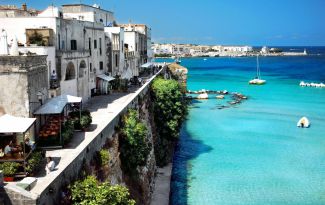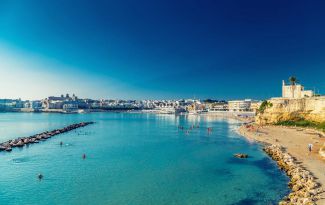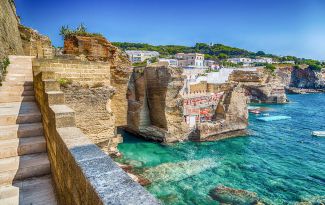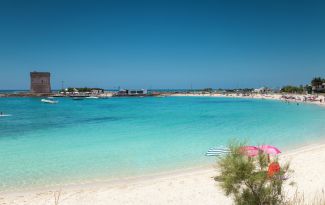the fantastic beaches and authentic culture of Gallipoli, Otranto, Santa Maria di Leuca, Porto Cesareo
SalentoIt is one of the most popular tourist destinations in recent years, and it's an area that must be explored: beaches, towns, nature parks, but above all, lots of fun and folklore.
Gallipoli, also known as the Pearl of the Ionian Sea, boasts a coastline with sandy beaches. It is renowned for its Baroque churches, Renaissance buildings, and balconies adorned with ornaments that are visible among the narrow streets of the old town. The ancient center is surrounded by city walls that were fortified until the previous century and can be reached via a new wooden bridge.
Otranto is the easternmost city on the Italian peninsula where the sun rises earliest. The coast here alternates between light gray sandy beaches and sometimes rocky shores. The old town is famous for the Aragonese Castle from the 15th century and the Cathedral, a celebrated example of Romanesque style.
Santa Maria di Leuca marks the southernmost point of Apulia and Italy! On either side, there is a cliff (to the east) and a sheltered cove with a lighthouse where you can enjoy an almost 360-degree view from the terrace of the two seas that meet here, the Adriatic Sea and the Ionian Sea.
Porto Cesareo is a resort on the Ionian coast of Salento, known for its long white sandy beaches and facing an archipelago of small islands in a sea with green crystal reflections. The island that stands out is the larger one known as the Rabbit Island, a nature reserve that provides a habitat for currently endangered species.
Porto Selvaggio is an enchanting and pristine coastal village that is part of the Porto Selvaggio Regional Park. This park covers 420 hectares, nearly half of which are covered in forest.
The ancient town of Specchia is featured in the guide "The Most Beautiful Villages of Italy." Narrow, winding streets interrupted by staircases that were not architecturally planned but spontaneously emerged, and many of them have remained intact.
Accommodations in this area:

Masseria L'Uliveto - Otranto, Lecce

La Macchiola & Corti del Mito-Spongano, Lecce

Masseria Palane - Patù

Tenuta Specolizzi - Lido Marini, Lecce

Masseria La Gresca - Ortelle, Lecce

Masseria Panareo - Otranto

Antica Masseria Pescu - Presicce

Tenuta Monticelli - Alezio, Gallipoli

Relais Corte Palmieri - Gallipoli

Masseria Muntibianchi - Otranto

Masseria Galatea - Alessano

Relais Tenuta Campì - Martano, Lecce

Agriturismo Matine - Alessano

Dimora Duchessina - Minervino di Lecce

Villa Ciardo - Alessano

Masseria Don Agostino - Martano (LE)

Palazzo De Mori - Otranto

Masseria Palombara Resort & Spa

Masseria Mongiò dell'Elefante

Palazzo Ducale Venturi - Minervino di Lecce

Tenuta Centoporte - Giurdignano

Naturalis Bio Resort - Martano

Masseria Prosperi - Alimini

Masseria Fano - Salve

Palazzo Castriota - Alezio

Bio Masseria Santa Lucia - Alessano

Villa le 2 Sorelle - Ugento, Lecce

Torre del Cardo - Porto Cesareo, Lecce

Mulicchi Resort - Salento, Lecce

Masseria dei 12 Granai - Otranto, Salento

Villa Li Cuti - Lecce

Masseria Bandino - Otranto, Lecce

Tia Maria Country Inn - Gallipoli, Lecce

Le Capase Resort - Santa Cesarea, Otranto

Tenuta Flora Maria - Porto Cesareo, Leverano

Palazzo Guglielmo - Vignacastrisi, Lecce

Villa Valeria - Morciano Di Leuca, Lecce

Villa Rosalorè - Ugento, Salento

Villa Aura - Montesano Salentino








